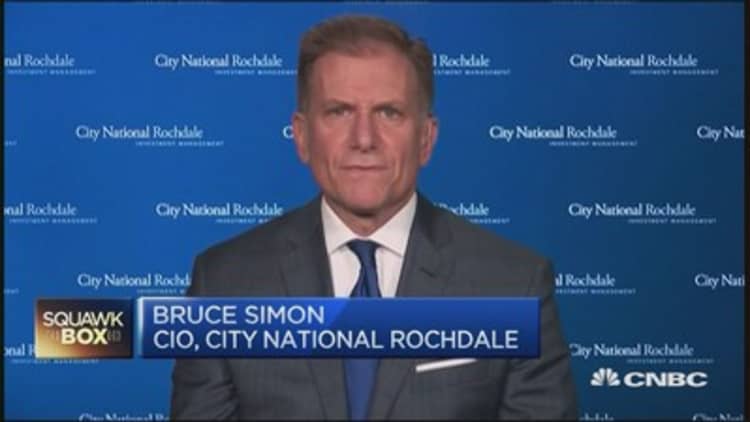The good news: Asia Pacific is expected to remain the fastest-growing area of the global economy in 2016, according to IHS Global Insight. The bad news: a slew of factors threaten to imperil economic activity in the region.
In a note to clients, Rajiv Biswas, chief economist for Asia Pacific at IHS, wrote the region's growth prospects are supported by numerous regional, bilateral free-trade agreements and development initiatives such as the Asian Infrastructure Investment Bank.
Biswas told CNBC he expects the base case scenario for Asia Pacific economic growth to be 4.6 percent in 2016, broadly similar to last year's pace.
There are several headwinds, however, that threaten to derail the region's growth prospects:
Contagion effect of China's economic rebalancing
Most economists forecast China's annual growth for 2016 and beyond to remain below the 7 percent mark as the economy undergoes a major transformation to even out imbalances built during the boom years.
The country's rapid growth in the last decade resulted in its "share of world [Gross Domestic Product] rising from 5 percent in 2005 to an estimated 15 percent in 2015," said Biswas. This has increased the rest of Asia's exposure to China, which has become a major trading partner and market for exports.
Asian countries were the "biggest winners when China was rising in the last decade" but now "they are the most vulnerable to the China slowdown," Biswas said.
IHS estimates China's growth for 2016 to be at 6.3 percent, with consumption becoming an important driver for growth, contributing to an estimated 58 percent of GDP growth in 2015 and spurring on the services sector. Biswas said the chance of an economic hard landing in the next two to three years stood at 25 percent.
UBS Wealth Management echoed similar concerns over China in their 2016 outlook released late last year. The worries include high leverage, over-reliance on credit for growth, oversupply in property markets, and overcapacity in industrial sectors.
Further down the road, however, China faces another notable challenge - an older workforce. In his recent book, Asian Megatrends, Biswas explained an already aging demographic will start to tighten China's labor force, acting as a drag on economic growth.
China's taking steps to address the issue. Last year, Beijing amended its long-held one-child policy to prop up falling birth rates but the impact, if any, will not be felt in the immediate future.
Spillover from Asia's corporate debt market
The impact of China's slowdown, and its effect on rest of the region, will also put corporate borrowers in Asia with large foreign-currency debt under pressure, particularly if the dollar continues to rise against local currencies.
"Globally," Biswas noted, "corporate defaults in 2015 had already reached their highest level since 2009."
This number could rise further in 2016, especially as non-bank borrowers in China had an estimated 1.2 trillion of dollar debt outstanding by mid-2015. Similar concerns linger over Indonesian corporate borrowers, who have been hit by both a slump in global commodity prices and the depreciation of the rupiah.
Biswas said Indonesian non-bank borrowers held an estimated 160 billion of dollar debt in mid-2015, "equivalent to about 60 [percent] of Indonesian external debt and significantly exceeding Indonesia's foreign-exchange reserves in 2015."
Capital outflows from Asian emerging markets
IHS expects four interest rate hikes in 2016 from the U.S. Federal Reserve and that process of tightening "could result in further capital flows out of emerging market equities and also emerging bond markets," said Biswas.
Risk aversion and investor perception of negative transmission effects on Asian exports and investment flows as a result of China's slowdown could see further capital outflows to U.S. and EU markets, where "growth momentum is improving."
Capital outflows have accelerated in many emerging markets due to slower growth as well as weakness in their creditworthiness.
Net outflows from emerging markets in 2015 were pegged at $541 billion by the Institute of International Finance, driven by a sustained slowdown in EM growth and uncertainty about China, it added.
Iran as a major oil player

As prices languish in the sub-$30 region, the emergence of Iran could lead to further shake up in an already oversupplied oil market and have a subsequent impact on growth prospects for oil-dependent Asian economies.
Economic sanctions against Iran were lifted on Saturday and Iran's oil minister said last December the country would not consider curbing oil production once restrictions are eased.
Biswas said when allowed back into the market, Iran could "come back with additional oil exports" very quickly, adding to the supply glut. Iran already exports about a million barrels a day and has the technical ability to add further 500,000 to 600,000 barrels to its exports in a couple of months.
"The collapse of oil and gas prices, as well as prices for other major commodities such as iron ore and traded thermal coal, has caused economic shockwaves for many commodity-exporting nations," Biswas said, pointing to Indonesia, one of the hardest hit commodity exporting-EM in the region.
Indonesia is expected to grow at 4.5 percent in 2016 according to IHS estimates, easing from a 6 percent clip in 2012.
Since the financial crisis of 1998, a wave of investment into coal and other commodities have been driving Indonesia's growth. These investments are looking less compelling as commodity prices crater.
"They need to restructure their economy away from that dependence on commodity towards a more manufacturing driven economy," said Biswas, adding the government is not "fully committed to that right now."
Escalating tensions between Saudi Arabia and Iran, on the other hand, will add to further volatility to the oil price outlook for 2016, which Biswas expects to remain weak.




